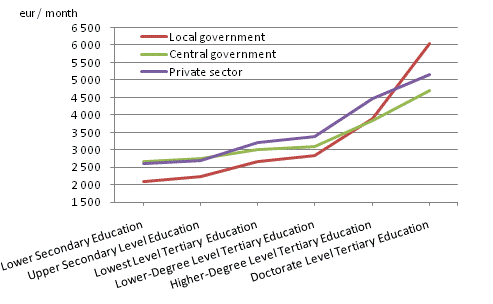Published: 12 November 2010
Education had the most significant effect on pay among local government wage and salary earners in 2009
According to Statistics Finland’s Structure of Earnings statistics, when comparing the total earnings of full-time wage and salary earners in different employer sectors in 2009, the higher level of education pushes the level of earnings up the most for the wage and salary earners employed by local government. Higher level qualifications had a pay rising impact in all employer sectors, especially completion of higher university and doctorate level education seems to have a significant effect on the pay level.
Monthly earnings by employer sector and level of education in 2009

The average earnings of those with doctorate level education were quite high particularly in the local government sector in relation to lower level qualifications. The large pay differentials with other levels of education in the local government sector are partly explained by that the majority of those with doctorate level education are doctors or teachers in higher level education, whose pay is high relative to other local government occupations. It should also be noted in this examination that the effects of other factors than education on pay were not considered, so the pay differentials may be based on other factors than the level of education, such as occupation, age or the employer's industry.
The average monthly earnings of all full-time wage and salary earners amounted to EUR 2,977 in the last quarter of 2009. The average earnings of wage and salary earners in central government amounted to EUR 3,321, in the private sector to EUR 3,040 and in the local government sector to EUR 2,731. These differences in earnings result from, i.a., structural differences related to wage and salary earners and tasks in different employer sectors.
These data derive from Statistics Finland's Structure of Earnings statistics, which cover all employer sectors. Monthly earnings for total hours worked are only calculated for full-time wage and salary earners. Besides earnings for regular working hours, the earnings also include pay for any possible overtime and working hour supplements but not one-off performance-based bonuses.
Monthly earnings by major group of the Classification of Occupations and employer sector in 2009
| Clasiification of occupations | Total earnings, EUR/month | |||
| Total | Private sector | Local government | Central government | |
| 1 Legislators, senior officials and managers | 5 184 | 5 413 | 4 281 | 5 254 |
| 2 Professionals | 3 782 | 4 077 | 3 506 | 3 627 |
| 3 Technicians and associate professionals | 3 021 | 3 181 | 2 629 | 2 867 |
| 4 Clerks | 2 441 | 2 522 | 2 146 | 2 363 |
| 5 Service and care workers, and shop and market sales workers | 2 230 | 2 169 | 2 222 | 3 025 |
| 6 Skilled agricultural and fishery workers | 2 064 | 1 841 | 2 086 | 2 488 |
| 7 Craft and related trades workers | 2 727 | 2 744 | 2 440 | 2 591 |
| 8 Plant and machine operators and assemblers | 2 717 | 2 726 | 2 414 | 2 462 |
| 9 Elementary occupations | 2 106 | 2 161 | 1 995 | 2 173 |
| 0 Armed forces | 3 679 | - | - | 3 679 |
| Unknown | 2 847 | 2 885 | 2 279 | 2 996 |
Source: Structure of Earnings 2009, Statistics Finland
Inquiries: Mika Idman (09) 1734 3445, Jukka Pitkäjärvi (09) 1734 3356, palkkarakenne@stat.fi
Director in charge: Kari Molnar
Publication in pdf-format (257.5 kB)
- Reviews
-
- Gender pay gap narrowed in 2009 (12.11.2010)
- Tables
-
Tables in databases
Pick the data you need into tables, view the data as graphs, or download the data for your use.
Appendix tables
- Appendix table 1. Average monthly earnings of full-time wage and salary earners by employer sector and field of education in 2009 (12.11.2010)
- Appendix table 2. Average monthly earnings of full-time wage and salary earners by employer sector and age in 2009 (12.11.2010)
- Appendix table 3. Average hourly earnings of wage and salary earners by major group of the Classification of Occupations and employer sector and in 2009 (12.11.2010)
Updated 12.11.2010
Official Statistics of Finland (OSF):
Structure of Earnings [e-publication].
ISSN=1799-0092. 2009. Helsinki: Statistics Finland [referred: 28.12.2025].
Access method: http://stat.fi/til/pra/2009/pra_2009_2010-11-12_tie_001_en.html

